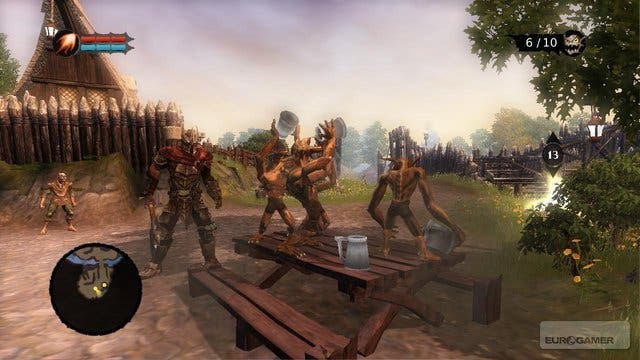Overlord: Raising Hell
Beyond good and evil.
As the game unfolds, and your horde size increases (from five up to a maximum of 50), Overlord starts to develop the puzzle and strategic elements so you can no longer wade in and win by strength in numbers. On occasions, your entire army can be wiped out by one careless decision. But as irksome as it can be to have your carefully harvested crop decimated, the game offers simple ways to restock supplies; being able to teleport back to the Dark Tower at any time, and then to all the key locations in the game, gets you out of a jam.
That said, on the Xbox 360 and PC original, the baffling absence of a mini-map would often make it a real trial to work out where to go, or where you hadn't yet been. With the feedback evidently taken on board, Triumph has added a simple mini-map to the bottom left of the screen on PS3, with helpful icons giving you an instant visual reference point for key objectives, minion gates and teleporters.
Best of all, a 'fog-of-war'-style indicator on the mini-map makes it easy to spot whether you've wandered down a specific path or not - quite essential given how samey certain sections can be when you're not familiar with them. Slightly annoying, though, is the continuing absence of a bigger overall in-game map. As with any openworld game of sprawling, interconnected environments, it's important to see where you are in relation to the world as a whole - something the mini-map fails to offer.
Other little quibbles have been fixed, mercifully. For example, pre-PS3, minions were often mysteriously left behind and failed to catch up with you, but that's much better now. Blues used to get caught up breaking things and collecting treasure, rather than being useful and healing, which meant they tended to die way before they were able to serve their purpose. Now, happily, they're a bit tougher, and more likely to be useful as healers when you need them.

Elsewhere, the occasionally wayward automatic camera system now feels solid, while the often-baffling lock-on system has been modified to give the player more chance of targeting the most likely item of interest. The ridiculous repeating speech as you walked around no longer loops until you want to hit things, either. Without being harsh, this version is the game it should have been in the first place: it actually feels play-tested. It feels polished, and almost every issue that matters has been ironed out. As an extra bonus to PS3 owners, they also get all the 360's downloadable content included as standard, making an already fairly large game bit of a monster when compared with the namby-pamby six-to-eight hour campaigns you generally see these days.
The one question mark, at this point, is over the pricing. A year on, you can easily pick up the PC and 360 originals for a song, so it rather puts this full-price release in a bad light. Still, for once, PS3 owners end up with the best version. I would talk about the multiplayer angle, maybe wax on about the co-op survival, the Vs. slaughter or pillage mode, but as diverting as they are, they aren't the reason you'll want to buy it: the single-player campaign is the star of the show by a long, long way, and the passage of time has done nothing to dull its charms.
In fact, Overlord: Raising Hell is probably one of the best games currently available on PS3, blessed with clever design, engaging characters, sharp dialogue and a moreish appeal that drags you through even when the going gets tough. The skillful melding of action-adventure with strategic puzzle elements marks it out as something distinct, and it's got cult hit written all over it. In such situations I'm often tempted to make pleading faces that you give it a try, because you might find, as I did, that it's a rare treat: an under-hyped, extremely enjoyable, thoroughly evil gem of a game. So let's hope that number down there gets you interested. Go forth and do my bidding.
